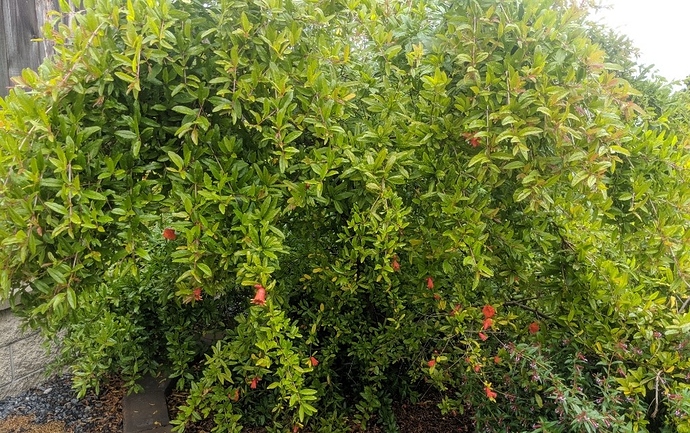Yep. Here’s hoping it doesn’t weigh itself down too much to cause too much damage, at least till after the fall harvest. My poor Washington Navel this year almost self destructed carrying so many oranges.
Maybe it’s a problem with the white balance in the photo, but foliage looks too yellowish. Healthy pomegranates have darker green leaves. Yellowish leaves usually signal iron deficiency.
Thanks for noticing  . I’ll give it a foliar feeding when the rain leaves town.
. I’ll give it a foliar feeding when the rain leaves town.

I planted pomegranates last year; we are in zone 7A (used to be 6B) so I was looking for relatively cold hardy varieties. I had five plants, two haven’t leafed out yet so I may have lost them but three are looking healthy this spring: Salavataski, Sumbar, and Kazake.
If they haven’t leafed out yet, they are probably toast. Mine leafed out in Feb. Flowered late April, and many full blooms now.
What zone are you in? Nothing leafs out in February here!
9b inland NorCAl
Please start a new thread to discuss the Sumbar cultivar. Many readers who won’t see it here will be interested.
I may need to wait until I have more to say  so far all I know is that it survived our winter outdoors; we had a fair bit of snow this year but I don’t think the overall temperatures got as low as they sometimes do. Then again I didn’t do anything in particular to protect the plants. Does give me hope that pomegranate growing is possible in this climate.
so far all I know is that it survived our winter outdoors; we had a fair bit of snow this year but I don’t think the overall temperatures got as low as they sometimes do. Then again I didn’t do anything in particular to protect the plants. Does give me hope that pomegranate growing is possible in this climate.
Maybe I’ll start a thread about growing pomegranates in zone 7.
Got this one at the San Jose scion exchange. It looks like atleast one of my cuttings is putting out roots.
You don’t want to bring down the height this time?
The fruit will occur there and then cause the whips to hang down 3’-4’ feet from the ground.
Hello Richard how are you?
Please can you tell me how i see that a pomegranate is already ready to pick? Thanks! ![]()
During the summer the fruits grow to almost full size. Then towards the end of summer sugars start to develop which causes them to swell and the skins to stretch. You will see uneven swelling and stretch marks. A week or many weeks later (depending on climate) one or more will show a crack. That is the day to harvest them all.





